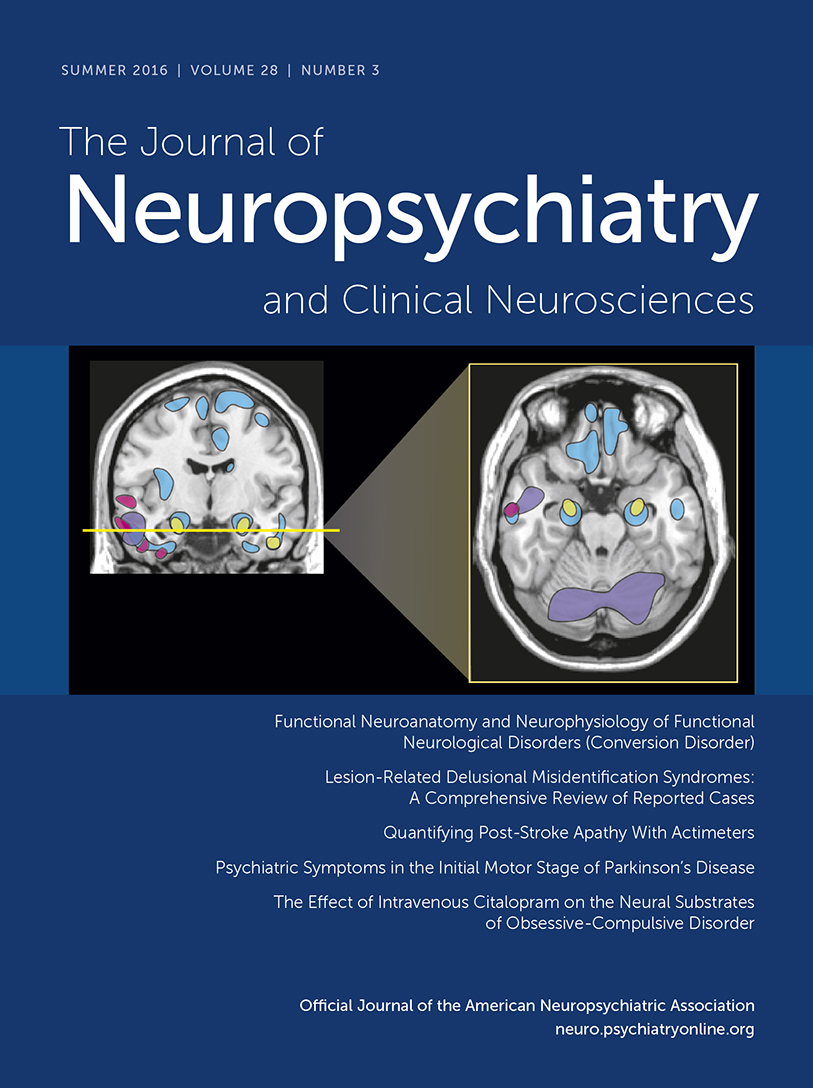Deficits in Limb Praxis in Patients With Obsessive-Compulsive Disorder
References
- 1 : Psychiatric symptoms associated with focal hand dystonia. Mov Disord 2010; 25:2249–2252 Crossref, Medline, Google Scholar
- 2 : Obsessive compulsive disorder among idiopathic focal dystonia patients: an epidemiological and family study. Biol Psychiatry 2002; 52:356–361 Crossref, Medline, Google Scholar
- 3 : Obsessive-compulsive symptoms in primary focal dystonia: a controlled study. Mov Disord 2011; 26:2274–2278 Crossref, Medline, Google Scholar
- 4 : Myoclonus-dystonia, obsessive-compulsive disorder, and alcohol dependence in SGCE mutation carriers. Neurology 2007; 68:522–524 Crossref, Medline, Google Scholar
- 5 : Limb apraxias: higher-order disorders of sensorimotor integration. Brain 2000; 123:860–879 Crossref, Medline, Google Scholar
- 6 : Patients with primary cervical dystonia have evidence of discrete deficits in praxis. J Neurol Neurosurg Psychiatry 2011; 82:615–619 Crossref, Medline, Google Scholar
- 7 : A novel technique for the quantitative assessment of apraxic deficits: application to individuals with mild cognitive impairment. J Neuropsychol 2007; 1:237–257 Crossref, Medline, Google Scholar
- 8 : The Birmingham Cognitive Screen (BCoS). London, Psychology Press, 2012 Google Scholar
- 9 : Apraxia and the parietal lobes. Neuropsychologia 2009; 47:1449–1459 Crossref, Medline, Google Scholar
- 10 : Selective impairment in visual perception of biological motion in obsessive-compulsive disorder. Depress Anxiety 2008; 25:E15–E25 Crossref, Medline, Google Scholar
- 11 : A meta-analysis of cortical inhibition and excitability using transcranial magnetic stimulation in psychiatric disorders. Clin Neurophysiol 2013; 124:1309–1320 Crossref, Medline, Google Scholar
- 12 : Presupplementary motor area hyperactivity during response inhibition: a candidate endophenotype of obsessive-compulsive disorder. Am J Psychiatry 2012; 169:1100–1108 Crossref, Medline, Google Scholar
- 13 : Effects of noise letters upon identification of a target letter in a nonsearch task. Percept Psychophys 1974; 16:143–149 Crossref, Google Scholar
- 14 : Overactive performance monitoring in obsessive-compulsive disorder: ERP evidence from correct and erroneous reactions. Neuropsychologia 2008; 46:1877–1887 Crossref, Medline, Google Scholar
- 15 : The meaning of meaningless gestures: a study of visuo-imitative apraxia. Neuropsychologia 1997; 35:333–341 Crossref, Medline, Google Scholar
- 16 : Goal-directed imitation in patients with ideomotor apraxia. Cogn Neuropsychol 2005; 22:419–432 Crossref, Medline, Google Scholar
- 17 : Evidence accumulation in obsessive-compulsive disorder: the role of uncertainty and monetary reward on perceptual decision-making thresholds. Neuropsychopharmacology 2015; 40:1192–1202 Crossref, Medline, Google Scholar
- 18 : Neuropsychological evidence for a strategic control of multiple routes in imitation. Brain 2007; 130:1111–1126 Crossref, Medline, Google Scholar
- 19 : Neuropsychological perspectives on the mechanisms of imitation. Philos Trans R Soc Lond B Biol Sci 2009; 364:2337–2347 Crossref, Medline, Google Scholar
- 20 : Neural representations of skilled movement. Brain 2000; 123:2306–2313 Crossref, Medline, Google Scholar
- 21 : Neural underpinnings of gesture discrimination in patients with limb apraxia. J Neurosci 2008; 28:3030–3041 Crossref, Medline, Google Scholar
- 22 : Involvement of the inferior frontal junction in cognitive control: meta-analyses of switching and Stroop studies. Hum Brain Mapp 2005; 25:22–34 Crossref, Medline, Google Scholar



